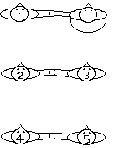
Starting Position
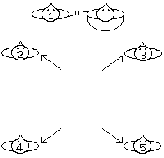
Bars 6-9
Man 1 is in front of the square, facing up the hall. The other
four men are all looking at the woman.)
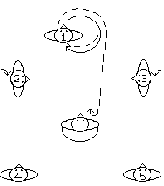
Bars 10-15
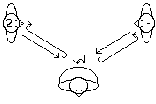
Section III, 1st Time
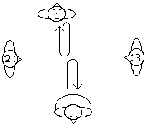
Bars 16-19, 3rd Time
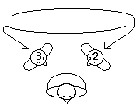
Bars 20-22
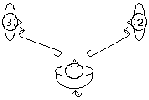
Bars 25-27
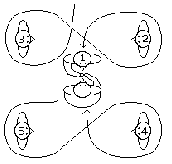
Bars 28-35
| Steps: | Sempio (in 6), Doppio (in 6), Piva (in 4), Saltarello (in 4 and 6), Meza Ripresa (in 4), Mezavolta, Voltatonda, Reverenza. |  Starting Position |
| Start: | Man 1 and Woman in front, holding hands, Woman on the right. Man 2 and Man 3 are four steps behind them, holding hands, Man 3 on the right. Man 4 and Man 5 are four steps behind them, also holding hands, Man 5 on the right. Everyone is facing up the hall. | |
| 1-5 (3 times) | 1 bar of introduction (no movement), and 14 Saltarelli, starting on Outside foot, (Man 1, Man 2 and Man 4 on Left, Woman, Man 3 and Man 5 on Right.) | |
 Bars 6-9 | ||
| 6-9 | Man 2 does 4 Meze Riprese Left and forward a little, | |
| as | Man 3 does 4 Meze Riprese Right and forward a little, | |
| as | Man 4 does 4 Meze Riprese Left and backward a little, | |
| as | Man 5 does 4 Meze Riprese Right and backward a little. (Men 2,3,4 and 5 have formed a square shape, approximately eight steps on each side. (This will be referred to as the square for the rest of the dance.) Man 1 and Woman are about two steps in front of them.) | |
| 10-12 | Woman and Man 1 take right hands and Piva Left, Piva Right, Piva Left, circling each other back to place. Drop hands. (Man 1 ends facing up the hall, Woman is facing down.) | |
| 13-15 | Woman Piva Right, Piva Left, Piva Right ending with Mezavolta Right, as Man 2 and Man 3 turn as she goes by so they end facing in her general direction. (Woman is in the center of the square, facing up the hall. Man 1 is in front of the square, facing up the hall. The other four men are all looking at the woman.) |
 Bars 10-15 |
| 16 | Man 2 and Man 3 Doppio Right up to Woman. | |
| 17 | Man 2 and Man 3 Reverenza Left and try to touch Woman's hand, | |
| as | Woman ends with a small Step Right Backwards, indignantly. |  Section III, 1st Time |
| 18 | Beat 1 = Woman, Man 2 and Man 3 Mezavolta (Step Left, turning counterclockwise.) | |
| Beats 2-3 = Man 2 and Man 3 Hop on Left foot. | ||
| Beats 4-6 = Man 2 and Man 3 start a Saltarello Right. (This saltarello is quite slow.) | ||
| 19 | Beats 1-3 = Man 2 and Man 3 finish the Saltarello Right, returning to their place in the square. | |
| Beat 4 = Man 2 and Man 3 Mezavolta (Step Left, Man 2 turning clockwise, Man 3 counter-clockwise, ending facing each other.) | ||
| Beat 5 = Man 2 and Man 3 bring Right foot beside left, ending with weight on both feet. | ||
| Beat 6 = Pause. (Woman is now facing down the hall, in the center of the square. Men 2 and 3 are facing each other. The other three men are still facing up the hall.) |  Bars 16-19, 3rd Time | |
| 16-19 (2nd time) | Man 4 and Man 5 do the same as Man 2 and Man 3 did, Woman responding similarly, | |
| as | Man 1 ends with a Mezavolta Right. (Man 1 is facing down the hall and Woman up, while the others are facing inward across the set.) | |
| 16-17 (3rd time) | Man 1 and Woman Sempio Left, Sempio Right, Doppio Left, ending with a fast Reverenza Right (on the last two beats of the bar), touching left hands. | |
| 18-19 (3rd time) | Man 1 and Woman Doppio Right, Doppio Left, turning to the right to return to their places. (Man 1 is back in his place, outside of the group, facing up the hall, Woman is in the center of the square, facing down the hall. The other four are still facing each other across the set.) |  Bars 20-22 |
| 20-21 | Man 2 and Man 3 Saltarello Left, Saltarello Right, passing right shoulders, into each other's places. | |
| 22 | Man 2 and Man 3 Saltarello Left to Woman. (Man 2 and Man 3 are behind Woman, Man 2 to her left and Man 3 to her right.) | |
| 23 | Man 2 motions with his right hand at Man 3 and points at Woman. |  Bars 25-27 |
| 24 | Man 3 motions back with his left hand that he doesn't want to. | |
| 25 | Beats 1-2 = Woman notices movement of men behind her, | |
| Beats 3-4 = Woman Mezavolta Right, angrily, | ||
| as = Man 2 and Man 3 Mezavolta Left. | ||
| Beats 5-6 = Man 2 and Man 3 Hop on Left | ||
| 26 | Man 2 and Man 3 Saltarello Right to their new places. (Man 2 on the right side of the hall, Man 3 on the left.) | |
| 27 (half bar) | Man 2 and Man 3 Mezavolta (Step Left, Man 2 turning counterclockwise, Man 3 clockwise, ending facing each other) and bring Right foot beside left, ending with weight on both feet. (Man 2 and Man 3 are facing each other across the square, Man 2 on the side that Man 3 started on, and Man 3 on Man 2's original side. Woman is facing up the hall.) | |
| 20-27 (2nd time) | Man 4, Man 5 and Woman repeat, |  Bars 28-35 |
| as | Man 1 ends with a Mezavolta Right. (Man 1 and Woman are facing down the hall, while the others are facing inward across the set.) | |
| 28-35 | Man 1 8 Saltarelli, starting Left, in a figure-8, passing between Man 2 and Man 3, going clockwise around Man 3 and counterclockwise around Man 2; he ends in the middle, facing down the hall, and touches Woman's right hand. | |
| as | Woman 8 Saltarelli, starting Left, in a figure-8, passing between Man 3 and Man 5, going counterclockwise around Man 5 and clockwise around Man 4; she ends in the middle, facing up, and touches Man 1's right hand. | |
| 36-37 | Man 1 Saltarello Left, Saltarello Right, turning to the left and returning to his place. | |
| as | Woman Voltatonda (Saltarello Left, Saltarello Right, counterclockwise.) (Woman ends in center of square, Man 1 in his usual spot outside of it, both facing up the hall.) | |
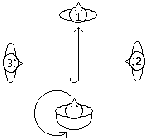 Bars 36-37 |
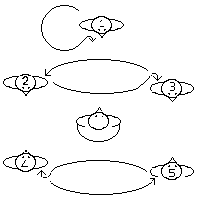 Bars 38-41, 1st Time |
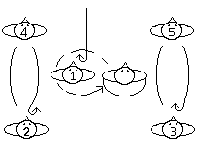 Bars 38-41, 2nd Time (Woman's Path Shown Dashed) |
| 38-41 | Man 2 and Man 3 switch places with 4 Pive (Man 2 starting on Right foot, Man 3 on Left), passing right shoulders, turning to face down the hall at the end, | |
| as | Man 4 and Man 5 do the same (Man 4 starting on Right foot and Man 5 on Left), turning to face up the hall at the end, | |
| as | Man 1 Voltatonda (4 Pive, starting Left, counterclockwise), ending with a Mezavolta Right. (Man 1, Man 2 and Man 3 are facing down the hall, the other three are facing up. All dancers are in the positions from which they started Section III.) | |
| 38-41 (2nd time) | Man 2 and Man 4 switch places with 4 Pive, starting Right, passing right shoulders, Man 2 ending with a Mezavolta Left, | 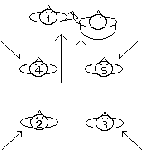 Bars 38-41, 3rd Time |
| as | Man 3 and Man 5 do the same, starting Left, Man 3 ending with a Mezavolta Right, | |
| as | Man 1 comes to Woman with 4 Pive, starting Left, ending with a Mezavolta Right, | |
| as | Woman Voltatonda (4 Pive, starting Left, counterclockwise.) (Everyone is facing up the hall. Man 1 and Woman are in the center of the square, Man 1 on the Left. Man 4 and Man 5 are in the upper corners of the square, Man 4 on the left, and Man 2 and Man 3 are in the lower corners, Man 2 on the left.) | |
| 38-41 (3rd time) | Men 2, 3, 4, 5 close in with 4 Meze Riprese, on Inside feet (Man 2 and Man 4 on Right, Man 3 and Man 5 on Left), | |
| as | Man 1 and Woman escape with 4 Pive, starting Left. (End with everyone in the starting position, facing up the hall, Man 1 and Woman in the lead, but the other men having exchanged positions, Man 4 (on the left) and Man 5 in the middle, and Man 2 (on the left) and Man 3 at the rear.) | |
Recordings
Mesura - Extra five-bar introduction. Works with this reconstruction. Section I and Section V are very strongly in 3/4 time, so our reconstruction of the saltarello may be difficult to do to them.
Dance Notes
Cornazano notes that this dance is the counterpart to Mercanzia, as the woman in Sobria only dances with her partner.
This dance is notable in its lack of details. There are many places, especially with turns, where the exact steps taken and foot which is moved are not specified. It is possible that this information was accidentally left out of the manuscripts and, by including our best guess at them, we are supporting that philosophy. However, it is at least as likely that the dancers were trusted to be able to perform the intent of the dance without having to memorize a specific sequence for every moment of it. In some dances a particular series of steps doubtless was the intent of the dance, but this dance is very theatrical, so the exact method of turning around was doubtless much less important than, for instance, that the woman should glare with annoyance at the men who are harassing her.
Bar 1: PnD starts with a movimento, but this has been presumed to be part of the saltarelli that follows.
No starting foot is given, so the outside foot was chosen in order that the four men that do meze riprese immediately afterwards will be on the correct feet.
Section I: The music for this section is clearly in 3/4 rather than 6/8. We have had the arrangement support a 6/8 rhythm, in order to make it easier to do our reconstruction of the saltarelli to this music.
Bars 6-9: No starting foot is given for the meze riprese, but the inside one is the obvious choice.
The exact size and shape of the formation that the four men end up in is not specified. They are said to be "in quadro" or "in quadrangolo", which is probably a square shape (as opposed to a rectangle, for instance), as at the end of the dance they exchange places across the square with the same steps as they do along the side of the square. In both these later exchanges the distance is covered by 4 pive, which should be about 8 or 12 steps. The starting distance between the middle two men and the last two men is only four steps apart, so we presumed that the meze riprese widen the set up and down as well as across it. Ending in a square about eight steps across works well, as it enables the men to change places with four pive without being too cramped, but doesn't put Man 2 and Man 3 too close to the front couple.
Bar 10: No starting foot is given in the sources.
Bars 13-15: No instruction is given in the sources for Men 2 and 3 to turn, but they will need to do so at some point in order to approach the woman. They might, instead, do a pivot immediately before they do the doppio in Bar 16, but we felt that a gradual turn, focusing on the woman, is more in keeping with the theme of the dance.
Section III, (1st two times): The description of this part of the dance lacks many details, which we have filled in, and the timing is also unclear. Alternate interpretations are very viable. What follows is a discussion of the general problems, while specific decisions regarding particular bars are given by their bar numbers.
The length of this section is clearly four bars but how exactly the steps fit into the music is not obvious. The first bar presumably takes the doppio, and the second has the reverenza. The rest of this section, which may start in the second bar, has the woman withdraw, the three dancers turn, the men hop (perhaps as they turn), the men return to their places with a saltarello (a doppio in Rvat), and, in PnD only, the men turn to each other and do a posada.
For our reconstruction, we chose to have the woman step backwards at the end of the second bar, as an immediate response to the men attempting to take her hand, and then to have a half-bar for both the turn and hop that occurs before the saltarello and for the turn and pause that appear after it. The drawback is that the saltarello itself is performed half in one bar and half in another, which can be quite awkward. The music does, however, have a distinctively different half-bar at the beginning of Bar 18 (the third bar), which fits this solution. (Also, it is worth keeping in mind that this barring is a modern notion that would not have been a concern of 15th-century dancers; the sources simply indicate a section of music that we have subdivided into four bars. There is no reason to believe steps must always begin at our bar lines, though they almost always do.)
An alternate solution is that the woman withdraws and the dancers turn in the third bar, and the last bar is for the saltarello, the men's turn and the posada. One problem with this solution is that there is a lot done at the very end of the last bar, especially when using a reconstruction of the saltarello with the hop at the end. (If this alternate reconstruction is correct, it might explain why Cornazano would turn the saltarello into a doppio, in order to leave room for a turn and closing feet, even if he did forget to include the extra instructions.) Another problem is that the third bar seems rather long for movements that could be done in half a bar, and would be more dramatic if done quickly in response to the woman's indignation.
Another solution is that the woman's step backwards and the turns are done at the end of the reverenza, in the second bar. This then leaves the third bar for the saltarello, and the fourth bar for a more leisurely mezavolta and a half-bar pause, but the second bar is very crowded. It is also strange that Cornazano would leave out an entire bar of the dance.
A further hindrance to working out this section of the dance is that the foot on which steps are done is not clear. After the reverenza left the men turn, do a salto or salteto (perhaps as part of the turn), and then a saltarello starting on the right. The turn and the salto do not have a foot assigned to them, and the method for the turn is not even given. After a reverenza left, the next foot used will normally be the left. The usual default for a mezavolta is a pivot on the foot already on the floor (rather than using the foot that is ready to be stepped on). And a salto, if it is a hop and not a leap, will also not change the foot used next. But if this pattern is followed, the reverenza left would be followed by a mezavolta right, a hop on the right foot, and then the left foot would be ready to step next, while the right is actually required for the saltarello that follows.
Possible reasons for this apparent inconsistency, aside from scribal errors, include that the turn is something that does change feet, such as a step, or that the salto is a leap from one foot onto the other, rather than a hop. (However, the dance Jupiter has a few occurrences of what appear to be a leap, and the instructions to do so, such as "butando se sulo pede drito", are used instead of salto.) The solution we chose, making the mezavolta be a step on the left foot, is only one possibility
Bar 17, (1st two times): The sources do not say that the woman takes a step, PnD merely saying "tiri si uno poco indrieto". Her movement backwards may be more correctly a recoil without any movement of the feet.
Bar 18, (1st two times): No details are given for the mezavolta. We decided to have it accomplished with a step, rather than the usual pivot, in order to put the men on the correct foot for the saltarello that shortly occurs. It is possible that the men's mezavolta is accomplished during the hop that we place after it. In this case the hop ("salteto" or "salto" in the manuscripts) might be a leap from the right foot to the left, in order to leave the men ready to do a saltarello on the right.
Bar 19, (1st two times): The mezavolta appears in PnD as an instruction that the saltarello should be done "como uno poco di volteta", and also says that the dancers end facing each other. That the turn isn't described as a mezavolta is perhaps because the turn is less than 180 degrees, the two men already being at an angle as they return to their places. This also indicates that they turn toward each other, rather than both turning the same way, so that both are doing a small turn, rather than one a big turn and the other a small one.
Bar 19 (1st two times) and 27: Both these bars end, in PnD only, with a "posada" or a "possa". What exactly this means is uncertain, but it may be a pause, some sort of mimed gesture (as in "a pose"), or simply ending with the feet together and weight on both. We are interpreting it as the last with, if there is extra time, a pause, but perhaps the intent was a mimed gesture between the two men, probably indicating that they really weren't all that interested in the woman. (See also the notes for Marchesana and Tesara, which also include this step.)
Bar 17 (3rd time): No hand is mentioned, but it is in the singular, so we chose to have them touch left hands, so that they will be starting to curve back to place.
Bar 18 (3rd time): No specifics are given as to how the dancers turn in order to return to their places. It is unlikely to be a pivoting mezavolta at the end of Bar 17, as that bar already has a reverenza added to it. Because the return path is one step larger than the path taken to come together (two doppii instead of two sempii and a doppio), a curving path can be easily accommodated, and we had them curve to the right because the first step is on the right foot.
Section IV: This section is very similar to Section III, and the timing is also uncertain. The three saltarelli that the men take in Bars 20-22 clearly fit that music. Then come three bars of bassadanza music, followed by what we decided were an upbeat and one and a half bars of quadernaria. To fit into this are:
Because we had the last turn and posada take half a bar in Section III we chose to have them do so here, and the saltarello should take one bar before that. This left the two gestures and the turn to each fit into one bar of bassadanza, with the salto on the upbeat.
Bar 20: No starting foot is given.
Bars 20-21: The side on which the men pass each other is not given in the sources.
Bars 23-24: It is not clear which man signals first and which second, but the first does use his right hand and the second the left. We decided that were using the hand closer to the other man, which prompted the decision about which signaled first.
Bar 25: The men are clearly told in PnD to turn at the same time as the woman turns ("in quello instante che se volta la dona") but we decided to put their turn a bit later, as a reaction to her turn, presuming that within the same bar would be close enough. No details were given for the mezavolta so we used a pivot for dramatic effect, but a doppio, done with menace by the woman and by the men with a sudden recollection that they had pressing business elsewhere, would be as effective.
Bar 27 (2nd time): Man 1's mezavolta is not mentioned and should perhaps be done as he starts his figure-8, with the first saltarelli.
Bars 35-36: Which hand to use, and Man 1's method of turning in order to return to place, are again, as in Bars 17-18, not specified, and our decisions were reached in a similar manner. Because the two saltarelli of Bars 36-37 are more than enough to return to his place, Man 1 includes his mezavolta with those steps, and turns to the left as he is starting on that foot. The hand the dancers use to touch is then the right.
Bars 38-41, (1st and 2nd time): The side on which Men 2-5 pass each other isn't specified, so we chose right, but left might be easier for the second time for people who are used to heys. No starting foot is given so we chose the one that puts them on the correct feet for the meze riprese that follow.
There are no turns mentioned at the end of each pass. The turn at the end of the first is obvious, but facing up the hall at the end of the second is not; it is possible that they all move in from an outward-facing direction.
There is also no turn mentioned for Man 1 when he arrives beside Woman. If she turns, instead, they would leave out of the bottom of the square.
Bars 38-41 (3rd time): The direction that Man 1 and Woman escape isn't specified, so we presumed forward.
Repeat: No repeat is specified in PnD, although the music ends with a repeat of the first bar (which we have not included in our reconstruction.) A repeat may have been expected, presumably done exactly the same, except that the men previously in the middle will be at the end.
Music Notes
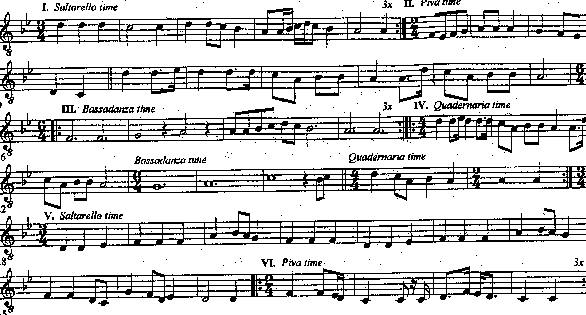
PnD contains a number of places where the steps and the music do not match, or the music was highly ambiguous. We did not have access to the Rvat manuscript, so on this piece of music we have used A. William Smith's transcription of it to supplement PnD and have largely followed Smith's suggested transcription (which combines the two). We chose to change Bars 26-27 from bassadanza time to quadernaria time to fit the reconstruction; PnD indicates this change while Rvat apparently does not.
One major difference that we have retained is that of key. PnD omits a clef but includes two flats in the key signature. We assert that there is only one way to place a B-flat and an E-flat a fifth apart on the staff (as shown in the manuscript), and so have inferred the transcription above, starting on D. (We are assuming that the second flat is an E, in keeping with standard practice then and now.) Smith's transcription of Rvat indicates 2 flats a third apart in the key signature. In his modern transcription Smith transposes the entire line up a third and drops the second flat, assuming the clef was in the wrong place. Marrocco transcribes it with the same pitches that we have used (though there are other differences caused primarily by the fact that Marrocco did a straight transcription of PnD rather than working in information from Cornazano).
If we believe the transcription we have made, then Sobria presents an interesting challenge: it is the only piece from this period that we have seen that is written in the Locrian mode. Theorists a century later shunned this mode as impractical, we think for good reason. It's difficult to write polyphony when the scale does not contain a perfect fifth! We attempted a two-part arrangement, not feeling brave enough to try three, but we have no real idea how a fifteenth-century composer would have arranged a piece in Locrian, so we're just guessing.